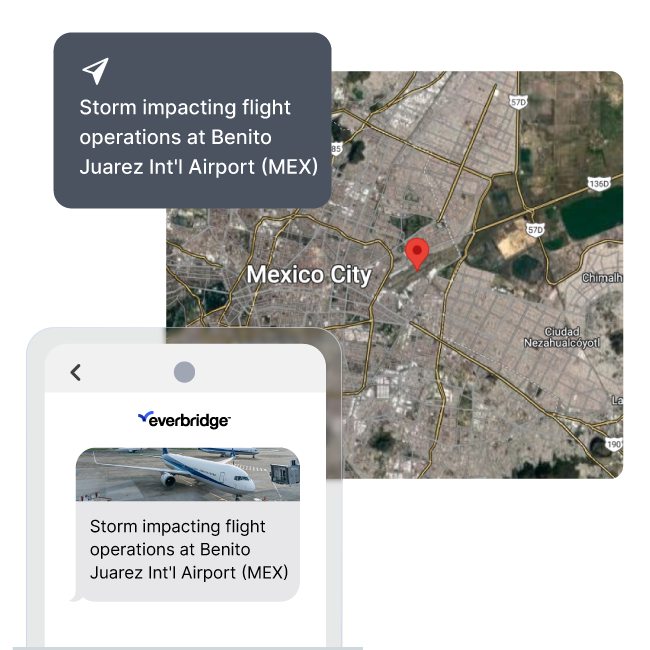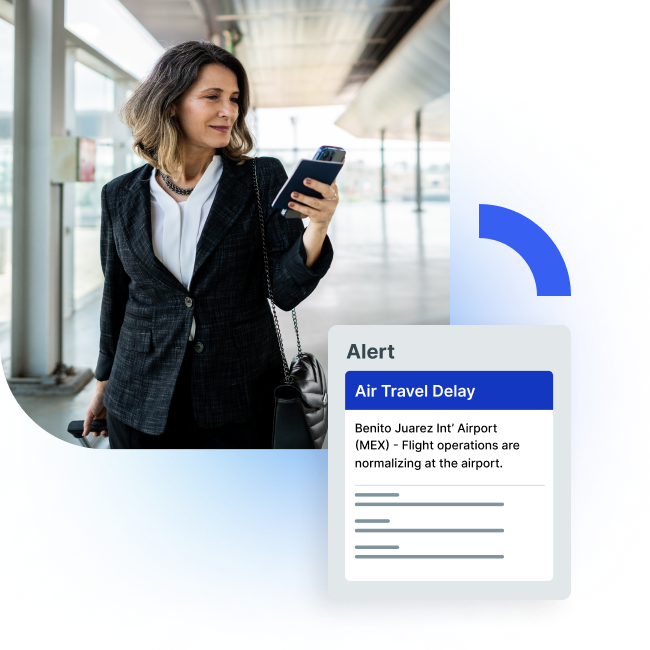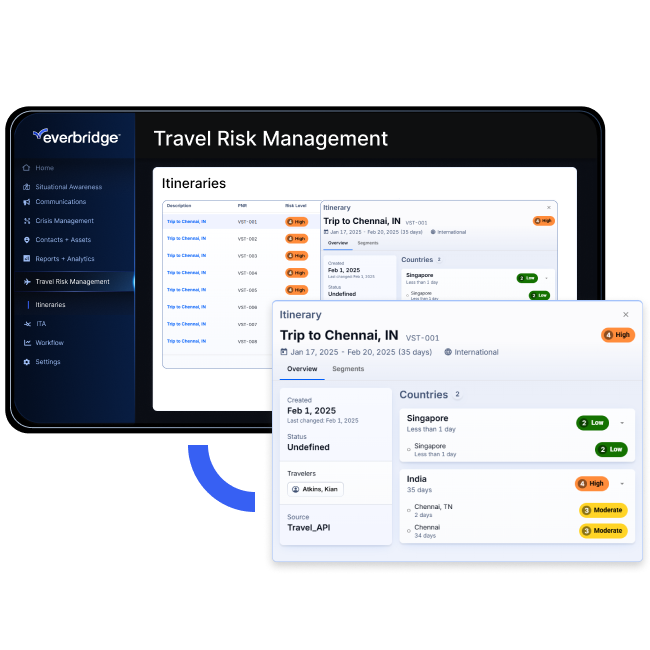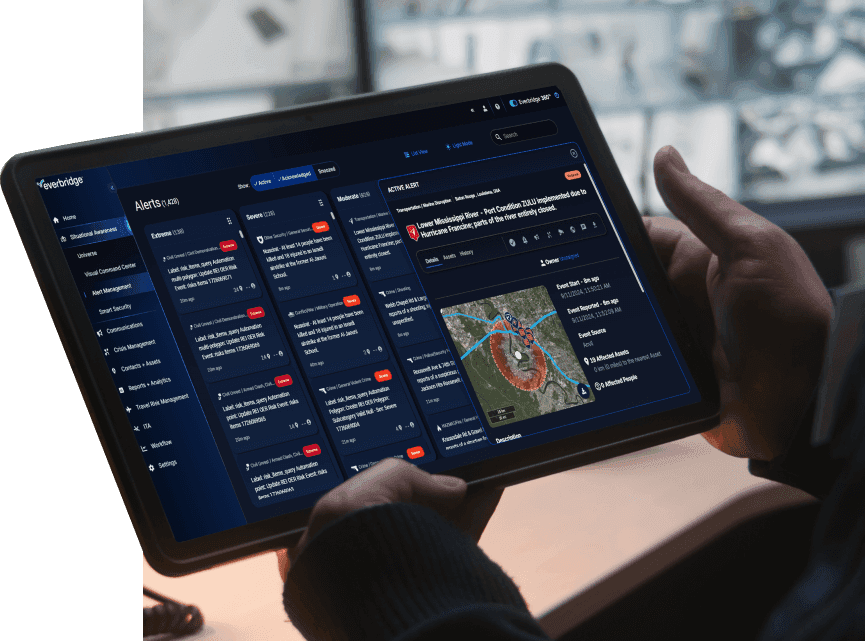Travel risk management
Provide peace of mind to your travelers through real-time threat monitoring, instant alerts, and 24/7 multilingual medical and security assistance. Equip them with the support they need, wherever their journey takes them.

Navigating evolving travel risks
Protecting your traveling employees is vital for their safety and your organization’s reputation. We prepare your team for travel, manage risks, and provide support every step of the way.
Our services include travel health screenings, psychological support, executive protection, security training, and 24/7 emergency assistance. With global coverage, we ensure your employees stay safe wherever work takes them.
Evolving and unpredictable travel risks
- Adapting to changing global risks.
- Preparing for and managing disruptions to travel plans.
- Ensuring traveler safety in higher risk environments.
Duty of care compliance
- Meeting legal obligations to protect employees while traveling.
- Providing pre-trip advisories, including risk intelligence.
- Demonstrating decision-making with a full audit trail.
Real-time threat awareness and communication
- Understanding risk data to prepare for threats.
- Sending real-time alerts to impacted employees.
- Ensuring clear and effective communication via multiple channels.
How Everbridge supports your organization and travelers

Travel Protector
Our travel risk management platform enables real-time monitoring of global risks, offering dynamic employee tracking and instant alerts to ensure traveler safety. It integrates risk data, communication tools, and situational awareness into a single platform.

Corporate Security & Protection
Our corporate security services provide risk assessments, secure journey management, executive protection, and emergency in-country support to ensure your team’s safety and peace of mind anywhere in the world.

Everbridge Assist
Everbridge Assist offers 24/7 multilingual medical and security support for global travelers and remote employees, providing expert health advice, emergency assistance, and critical care anywhere in the world with one call.
Keep your people safe, wherever they go, with Everbridge travel risk management solutions
Benefits
- Proactive traveler safety: Use real-time monitoring to protect employees during travel.
- Real-time responsiveness: Quickly address threats with accurate, automated data and communication tools.
- Centralized management: Simplify travel risk oversight with integrated tracking, data, and communication tools.
- Enhanced peace of mind: Ensure a safety-first travel experience with constant support and connectivity.
- Streamlined compliance: Meet duty of care standards with thorough risk assessments and documentation.

Features
- Pre-trip advisories: Share key information, including vaccination and visa requirements, and cultural insights.
- Customizable alerts: Tailor notifications and threat criteria to fit your organization’s needs.
- Emergency SOS: Enable travelers to request urgent help instantly with one-touch SOS capabilities.
- 24/7 assistance: Provide multilingual medical and security support during emergencies worldwide.
- Audit trails: Maintain a clear record of actions, to demonstrate compliance and decision protocols.

Factors to consider before purchasing a TRM solution
Concerned about traveler safety, but confused by all the solutions out there? Our eBook makes choosing the right travel risk management (TRM) solution easy. Featuring 20+ key questions, it highlights essential features and tools to help you decide. Protect your team and organization – download now for smarter, safer business travel.
“At Burns & McDonnell, safety is first. With more than 13,500 employees working from 70 offices globally, we are committed to creating safe environments in the office, in the field and while traveling. Everbridge Travel Protector is a robust and reliable solution to unify travel data, pre-trip travel advisories, automated traveler alerting, and dynamic location awareness to help keep our teams safe wherever they go.”
Robert J. “RJ” Hope, CPP, ABCP Principal & Director, Corporate Security & Travel, Burns & McDonnell
Ensure the safety and well-being of your travelers with Everbridge
Everbridge travel risk management solutions enhance traveler safety, streamline responses, and ensure effortless compliance. With real-time updates and connectivity, your travelers can navigate any destination with confidence. For your organization, these solutions provide greater situational awareness, simplified risk management, and well-documented decision-making backed by a detailed audit trail. The result? A safer, more secure travel experience that enables your organization to operate globally without compromising the well-being of your workforce.

Protect your mobile workforce
Discover how to ensure the safety of your employees with Everbridge travel risk management solutions. Learn about features like pre-trip advisories, critical event alerts, and real-time updates to keep your team protected.
Featured resources

Building a successful travel risk management program
A successful travel risk management plan enhances an organization’s resilience, helping them proactively protect their employees while engaged in business travel.

ISO 31030: Evolving expectations of travel risk management
Duty of care is a social contract between employer and employee – the employer agrees to take care of the employee, and the employee agrees to avoid unnecessary risk.

Core components of a travel risk management solution
To ensure traveling employees are kept safe, organizations must prepare their people for potential risks and keep them informed throughout their journey.

Travel risk management FAQs
Travel risk Management involves identifying, assessing, and mitigating potential risks to employees traveling for business. It ensures the safety and well-being of employees while meeting duty of care obligations, allowing organizations to manage risks effectively and maintain operational continuity.
A travel risk management program is a structured approach that organizations use to ensure the safety, security, and well-being of their employees or stakeholders when traveling for business or other purposes. It involves identifying, assessing, and mitigating risks associated with travel, such as health concerns, political instability, natural disasters, or logistical challenges.
A travel risk assessment is a process used to evaluate potential risks and hazards associated with a specific trip or travel destination. It helps individuals or organizations identify, analyze, and mitigate risks to ensure the safety and well-being of travelers.
With Everbridge, businesses can meet compliance by equipping employees with pre-trip advisories, tracking travel routes, and documenting responses through audit trails. These features provide transparency and defendable actions to demonstrate adherence to risk management protocols. Everbridge travel risk management solutions help mitigate travel risks and comply with ISO 31030 requirements.

